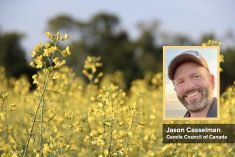In the mid-2000s, Albert Tenuta raised a few eyebrows when he referred to the discovery of soybean cyst nematode east of Toronto as good news. The field crops pathologist with the Ontario Ministry of Agriculture, Food and Rural Affairs (OMAFRA) meant that once the pest was identified, it could be monitored, and growers could better prepare themselves for dealing with it.
Now, in 2017, it’s with that same perspective that Meghan Moran, OMAFRA’s canola and edible bean specialist, is approaching clubroot in canola. Because its arrival in Ontario has been confirmed, growers can start the work of learning how to manage it.
Read Also

Sensing the soil: Root cell research finds ‘stress hormone’
Research into how root cells react to soil stressors could help plants better adapt to changes in their climate.
The discovery of the disease in a field near Verner, midway between Sudbury and North Bay, came during the 2016 growing season and sparked calls for increased vigilance and added testing in the canola-growing regions of Ontario.
In addition to confirmations of the disease in fields in Temiskaming and Nipissing, clubroot spores were also found south of Georgian Bay in Bruce, Grey and Dufferin counties.
This means another Western challenge has moved east, and it also means that Ontario’s canola growers must aim to keep the issue in balance.
This doesn’t spell an end to canola planting. But it could well be the last time growers can plant canola without taking clubroot into account.
“It does not mean growers should stop growing canola or do a great deal of expensive testing, but it does mean they need to make an effort to scout for clubroot and be aware of its important management practices,” Moran explains. “While you can’t truly eradicate clubroot once you have it in a field, it’s certainly possible to grow canola in an infected field and not experience any yield loss. For this, you must keep spore counts low, which means early detection, long rotations and using resistant varieties.”
Moran adds that all growers should be aware of the fact that clubroot has spread across the province (north and south) and make a point of scouting for it in each field during the growing season. This doesn’t require a lot of work; just watch for areas that mature faster than the rest of field, then pull a few plants before harvest and check for enlarged (galled) roots. Also check plants that are wilted, yellowed or stunted.
It’s also important to lengthen rotations — four years is better than three.
“A long rotation will provide significant protection against clubroot yield losses,” says Moran, noting it’s also a good defense against the swede midge numbers that had many growers opting out of canola production in 2015. “It’s another reason to focus on proper management of the crop and to keep up to date on best management practices and current news.”
In addition to scouting and longer rotations, Moran stresses the need for growers to sanitize their equipment, in part because most surveys find the highest spore loads at the entrance to fields. If you’re soil sampling for clubroot, concentrate the sample gathering at the entrance, and clean the dirt off equipment and sanitize using bleach. It’s also recommended that contaminated fields be tilled, planted and harvested last.
Resistance factor
Dan Orchard has seen some of the worst clubroot conditions in Canada. As an agronomy specialist with the Canola Council of Canada (CCC) for Central Alberta North, Orchard has had a front-row seat on clubroot and on how resistant varieties are losing the fight against the disease.
Where a spore count of 10,000 per gram of soil may signal the presence of the disease, Orchard has seen hot spots in Alberta where spore counts run as high as one billion per gram of soil.
Orchard sees the fact that canola isn’t a big-acreage crop in the east as a distinct advantage, and he also likes the fact that eastern rotations are somewhat longer than what’s commonly seen in the West.
“Typically, ours are one canola crop every two or three years, and that’s what causes the major problems where spore loads build up to uncontrollable, unmanageable levels,” says Orchard. “The clubroot’s likely in the soil for a few crops before these dead patches appear with the really heavy spore loads, so by then, it’s like playing catch-up. When growers are able to scout and diligently find it before the dead patches show up, the management is much easier and they have a few more options to deploy.”
That’s often when growers start to lengthen their rotations and use resistant varieties, while in Alberta and across most of the Prairies, the recommendation is to start using resistant varieties prior to clubroot showing up. That way, the spore loads should be kept in check well enough to avoid major problems. Once spore loads reach the “very high” level, variety resistance can begin to break down in just two growing seasons.
Somehow, the pathogen is finding its way around the resistance in those varieties, and that’s something Ontario growers must avoid. In most cases, Orchard notes that resistance usually comes when spore loads become extremely high. At that point in the West, opting out of canola until new resistant genetics are found is really the only measure.
Longer rotations may not be enough once spore loads climb to astronomic numbers. Even if 95 to 99 per cent of spores are not viable after three years, one per cent of a billion is still 10 million spores per gram of soil. That’s still a considerable concentration for growers to manage.
The work with new pathotypes is ongoing and Orchard notes that there have been 20 different pathotypes identified in Alberta, 11 of which are recent discoveries. Researchers were surprised to find there were that many and, in fact, didn’t have a classification system for naming them. Now they’ve identified a Canola Differential Set, to further classify these previously unidentified strains. Even in the West, says Orchard, the learning curve on clubroot in canola is almost straight uphill.
“As much as we think we’ve come along, and in particular the western Canadian research community… we realize how little everyone knows about this disease, and how much we have to learn, and how difficult the battle is going to be,” Orchard says.
In many ways, it’s a similar situation to soybean cyst nematode (SCN) or phytophthora root rot in soybeans in Ontario, where there is a heavy reliance on a single source of resistance. Orchard refers to it as the “Mendel gene” in canola, and is the low-hanging fruit and a source of genetic resistance that everyone had access to.
“We didn’t have many other options,” Orchard adds. “In hindsight, getting other genetics out would have been nice but the industry is working hard, and that single gene was a quick fix and we’re now realizing that that gene doesn’t last very long.”
Measuring and monitoring
Another measure that’s been undertaken in Manitoba and Saskatchewan is the development of distribution maps based on soil samples in each province. If used strictly as a sentinel to alert growers of the presence of clubroot, then it’s doing its job. However, soil sampling in a field can be problematic, since one core might have a zero spore load while another just two feet from it has a million spores. And even with as many as 10 cores in a composite sample, false negatives can be a problem.
Back in Ontario, Moran says work is ongoing to determine which pathotype of clubroot exists in the East. Work done by Dr. Mary Ruth McDonald at the University of Guelph indicates the pathotype commonly found infecting vegetable crops in Ontario is Pathotype 6, where in Alberta canola, they’ve been dealing primarily with Pathotype 3. That’s the pathotype that has been the most economically damaging.
“There are multiple pathotypes found in Alberta canola and the diversity can allow the disease to persist and escape the protection offered by resistant varieties,” says Moran. “In my opinion, it’s less important to determine how it got here, and more important to be aware now that the disease is present, then scout and test for the disease in our fields, and prevent further spread to additional fields.”
Moran adds that in reviewing some of the communications efforts from the CCC regarding the breakdown of clubroot resistance, it’s possible that growing a resistant variety can create a selection pressure that allows other pathotypes to proliferate. That can break down the utility of that variety. There’s also some difficulty in determining what pathotype a particular variety is resistant against; there are some very resistant varieties available in Ontario, yet not all varieties registered in Canada are offered in the East. Moran says she hopes that pipeline opens a little wider as the need increases.
“Even a resistant variety can struggle to yield when spore counts are very high in a field,” Moran says. “Growing a resistant variety in a field with high levels of the disease — like in the year after canola or after continuous canola or other host brassica crop — may not overcome the potential yield issues. As mentioned, that could lead to the faster breakdown of resistance. Growers should be using resistant varieties before spore loads get high, for instance, when a grower knows there’s clubroot in their area or if they believe they’re high risk.”
The important thing for now is to be informed. The disease has arrived in Ontario. It’s confirmed. So now is the time for monitoring, lengthening rotations, cleaning equipment, growing resistant varieties and keeping volunteer canola plants controlled.
For the full listing of tips and additional information, go to the Canola Council of Canada website at www.clubroot.ca.
















